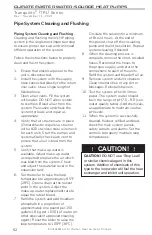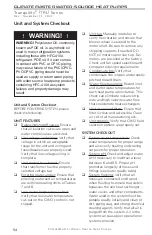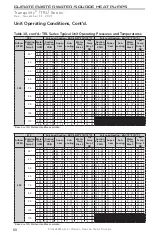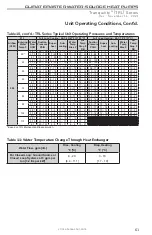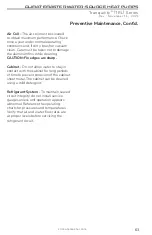
c l i m a t e m a s t e r.c o m
49
Tranquility
®
(TRL) Series
R e v. : N o v e m b e r 1 1 , 2 0 2 1
CLIMATEMASTER WATER-SOURCE HEAT PUMPS
Water Quality Standards, Cont’d.
1. The ClimateMaster Water Quality
Table provides water quality
requirements for coaxial & brazed
plate heat exchangers.
2. The water must be evaluated by
an independent testing facility
comparing site samples against
this Table. When water properties
are outside of these parameters,
the water must either be treated
by a professional water treatment
specialist to bring the water
quality within the boundaries of
this specification, or an external
secondary heat exchanger must
be used to isolate the heat pump
water system from the unsuitable
water. Failure to do so will void the
warranty of the heat pump system
and will limit liability for damage
caused by leaks or system failure.
3. Regular sampling, testing and
treatment of the water is necessary
to assure that the water quality
remains within acceptable levels
thereby allowing the heat pump to
operate at optimum levels.
4.
If closed‐loop systems are turned off
for extended periods, water samples
must be tested prior to operating the
system.
5. For optimal performance, it is
recommended that the closed‐loop
piping systems are initially filled with
de‐ionized water.
6. Well water with chemistry outside of
these boundaries, and salt water or
brackish water requires an external
secondary heat exchanger. Surface/
Pond water should not be used.
7. If water temperature is expected
to fall below 40°F, antifreeze is
required. Refer to the heat pump
IOM for the correct solution ratios to
prevent freezing.
α
Hydrogen Sulfide has an odor of
rotten eggs. If one detects this
smell, a test for H2S must be
performed. If H2S is detected above
the limit indicated, remediation is
necessary (Consult with your Water
Testing/Treatment Professional)
or a secondary heat exchanger is
required using appropriate materials
as recommended by the heat
exchanger supplier.
β
Suspended solids and particulates
must be filtered to prevent fouling
and failure of heat exchangers.
Strainers or particulate filters must
be installed to provide a maximum
particle size of 600 micron (0.60
mm, 0.023 in.) using a 20 to 30
mesh screen size. When a loop is
installed in areas with fine material
such as sand or clay, further filtration
is required to a maximum of 100
micron. Refer to the Strainer / Filter
Sizing Chart to capture the particle
sizes encountered on the site.
χ
An electrical grounding system using
a dedicated ground rod meeting
NEC and Local Electrical codes must
be installed. Building Ground must
not be connected the WSHP piping
system or other plumbing pipes.
δ
Refer to IOM for instructions on
measuring resistance and leakage
currents within water loops.
Do not use PVC pipe for water loop
(compressor POE oil and glycols
damage PVC) use of HDPE pipe is
recommended.


















